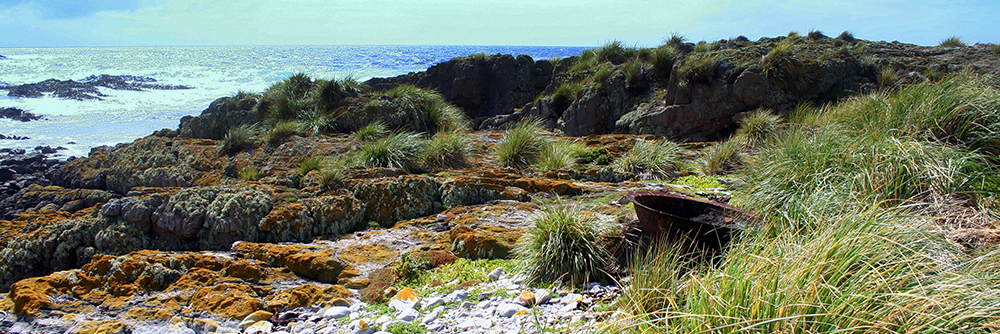Today the islands are uninhabited, from the late 19th century till around 1968 sheep were put on there to graze with shepherds visiting to tend to them when tides and weather permitted them to land. Buildings still remain from that era. Sheep have left Steeple and Grand Jason badly eroded in places. My Grandfather Arthur Porter shepherded on the Jasons around 1916. Having been there for many months he ran out of food and supplies so he rowed a small boat the 30 miles back to Carcass Island. When he was old and used to carve his schooners in our conservatory while he watched that my sister brother and I did our school work, he repeatedly told us this story and also how after he had dreamed he had found gold following a sheep into a gully, he had went to the place the next day and sure enough the sheep was there and when he went down to it he found the gold. He did have a claim staked on the gold; Jason Hansen of Carcass wrote to the manager of the FIC asking him to secure mining rights for about 300 acres in the joint names of Jason Hansen, his mother and Aurthur Porter, but it turned out to be Iron Pyrites, 'Fools Gold'. Grandad Porter however, was adamant that it was real gold and even late in life he wanted to go back there for it. The story was convincing though and we were told it so often that I remember dreaming and seeing the sheep at that gully too............Una Hurst
|
In the days of sail, many ships came to grief on the Jason Islands.
The Leopold of Antwerp, Belgium, a fine ship of 1200 tons under Captain Cousezeman, left Ostend early in 1858 for Swansea where she took on a cargo of coal. She sailed with a crew of 20 men including the captain, one having deserted in Swansea. On the 12 April 1858, at five o'clock on a dark rainy morning, travelling at a good speed, she struck Grand Jason to the North West of the Falklands. The men waited for daylight but the sea broke over the ship and carried away her three boats. A young man Leopold de Jouy bravely tried to swim to shore with a rope in his teeth but drowned, a second man tried and also drowned. By seven o'clock the ship was breaking up. Only one man called Peter de Clerck survived, thrown on the shore by the sea, he managed to scramble up the rocks. The Leopold and the rest of the crew had gone, none of the bodies washed up probably due to the thick tree kelp. Peter de Clerck survived for 23 days on the island living on birds and seal. By making a fire with wood and rope he attracted Captain Smyley in the Nancy who put his crew and boat in considerable danger to get the stranded man off the island. De Clerck had had nothing to eat for two days and was somewhat deranged when Smyley rescued him but recovered to tell the sorry tale of the Leopold.
12 July 1870 during 'a terrific storm on the night of the moon' the Alto, an American whaling barque under the command of Captain White from New Jersey wrecked on the Jasons.
On the night of 23/24 August 1871 the Mary Davidson a 3 masted barque, 275 tons built in Aberdeen and bound from Liverpool to Guayaquil with a general cargo, struck rocks and totally wrecked on Jason West Cay. Only three of the crew survived. They were picked up, after 27 days of 'suffering great privations' on the rocks, by the Florie (Captain Thomas Hicks) on 20th September 1871. All the crew had reached the island but seven perished of exposure.
February 1882 the Lady Dufferin, a British ship commanded by Captain J Fea, wrecked on the Jasons, her crew rowed to West Point Island.
Can you add/ correct any information or supply photographs or information , past or present/ life/ people/ buildings? Contact: falklands.southatlantic@gmail.com
Sources include: Falkland Rural Heritage- Joan Spruce with Natalie Smith, nationalarchives.gov.fk/Jane Cameron National Archives
Photographic credits: Jeremy Richards/Shutterstock.com, Gillian Santink/Shutterstock.com. |

 Steeple Jason and sealers try-pot- Terry Spruce
Steeple Jason and sealers try-pot- Terry Spruce